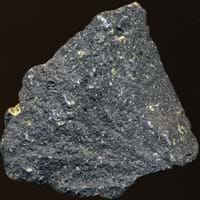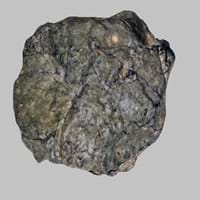Definition
Basalt is a common extrusive igneous rock formed by the rapid cooling of basaltic lava exposed at or very near the surface of Earth
Troctolite is a mafic intrusive rock type. It consists essentially of major but variable amounts of olivine and calcic plagioclase along with minor pyroxene. It is an olivine-rich anorthosite, or a pyroxene-depleted relative of gabbro
Discoverer
Georgius Agricola
Christian Leopold von Buch
Etymology
From Late Latin Basaltes (variant of basanites ), very hard stone, which was imported from Ancient Greek Basanites
From German Troklotit, from Greek trōktēs, a marine fish (taken to be trout)
Class
Igneous Rocks
Igneous Rocks
Sub-Class
Durable Rock, Medium Hardness Rock
Durable Rock, Hard Rock
Other Categories
Fine Grained Rock, Opaque Rock
Coarse Grained Rock, Opaque Rock
Texture
Glassy, Massive, Porphyritic, Scoriaceous, Vesicular
Phaneritic
Color
Black, Brown, Light to Dark Grey
Dark Grey to Black
Durability
Durable
Durable
Scratch Resistant
Yes
Yes
Appearance
Dull and Soft
Veined and Shiny
Interior Uses
Floor Tiles, Homes, Hotels, Kitchens
Bathrooms, Countertops, Decorative Aggregates, Entryways, Flooring, Homes, Interior Decoration, Kitchens
Exterior Uses
As Building Stone, Paving Stone, Garden Decoration, Office Buildings
As Building Stone, As Facing Stone, Garden Decoration, Office Buildings, Paving Stone
Other Architectural Uses
Curbing, Whetstones
Curbing
Construction Industry
Arrowheads, As Dimension Stone, Cobblestones, Cutting Tool, Rail Track Ballast, Roadstone
As Dimension Stone, Building houses or walls, Cement Manufacture, Construction Aggregate, for Road Aggregate
Medical Industry
Not Yet Used
Not Yet Used
Antiquity Uses
Artifacts, Monuments
Artifacts, Jewellery, Monuments, Sculpture
Commercial Uses
An Oil and Gas Reservoir, Commemorative Tablets, Creating Artwork, Used in aquariums
Cemetery Markers, Commemorative Tablets, Laboratory bench tops, Jewelry, Sea Defence, Tombstones
Types
Alkaline Basalt, Boninite, High Alumina Basalt, Mid Ocean Ridge Basalt (MORB), Tholeiitic Basalt, Basaltic trachyandesite, Mugearite and Shoshonite
Not Available
Features
Has High structural resistance against erosion and climate, Very fine grained rock
Smooth to touch
Archaeological Significance
Famous Monuments
Easter Island in the Polynesian Triangle, Pacific Ocean, Gateway of India in Mumbai, India, Gol Gumbaz in Karnataka, India
Data Not Available
Famous Sculptures
Data Not Available
Data Not Available
Pictographs
Used
Not Used
Petroglyphs
Used
Not Used
Formation
Basalt forms when lava reaches the Earth's surface near an active volcano. The temperature of lava is between 1100 to 1250° C when it gets to the surface.
Troctolite is a fine-grained, hard rock which is a type of metasomatite, essentially altered basalt. It forms with or without crystallization, either below the surface as intrusive rocks or on the surface as extrusive rocks.
Mineral Content
Olivine, Plagioclase, Pyroxene
Augite, Olivine, Plagioclase, Pyroxene
Compound Content
Aluminium Oxide, CaO, Iron(III) Oxide, FeO, Potassium Oxide, MgO, MnO, Sodium Oxide, Phosphorus Pentoxide, Silicon Dioxide, Titanium Dioxide
Aluminium Oxide, CaO, Chromium(III) Oxide, Iron(III) Oxide, Potassium Oxide, MgO, Sodium Oxide, Silicon Dioxide, Sulfur Trioxide
Types of Metamorphism
Contact Metamorphism
Burial Metamorphism, Cataclastic Metamorphism, Contact Metamorphism, Hydrothermal Metamorphism, Impact Metamorphism, Regional Metamorphism
Types of Weathering
Biological Weathering
Mechanical Weathering
Types of Erosion
Not Available
Chemical Erosion, Coastal Erosion, Water Erosion
Grain Size
Fine Grained
Coarse Grained
Fracture
Conchoidal
Conchoidal
Streak
White to Grey
Black
Porosity
Less Porous
Highly Porous
Luster
Not Available
Not Available
Cleavage
Not Available
Not Available
Specific Gravity
2.8-3
2.86-2.87
Transparency
Opaque
Opaque
Density
2.9-3.1 g/cm3
2.7-3.3 g/cm3
Specific Heat Capacity
Not Available
Resistance
Heat Resistant, Pressure Resistant, Wear Resistant
Impact Resistant, Pressure Resistant, Wear Resistant
Deposits in Eastern Continents
Asia
India, Russia
India, Russia
Africa
South Africa
South Africa
Europe
Iceland
Germany, Greece, Italy, Scotland, Turkey
Others
Not Yet Found
Greenland
Deposits in Western Continents
North America
Canada, USA
Canada, USA
South America
Brazil
Brazil, Colombia, Venezuela
Deposits in Oceania Continent
Australia
Not Yet Found
New Zealand, Queensland
All about Basalt and Troctolite Properties
Know all about Basalt and Troctolite properties here. All properties of rocks are important as they define the type of rock and its application. Basalt and Troctolite belong to Igneous Rocks.Texture of Basalt is Glassy, Massive, Porphyritic, Scoriaceous, Vesicular whereas that of Troctolite is Phaneritic. Basalt appears Dull and Soft and Troctolite appears Veined and Shiny. The luster of Basalt and Troctolite is not available. Basalt is available in black, brown, light to dark grey colors whereas Troctolite is available in dark grey to black colors. The commercial uses of Basalt are an oil and gas reservoir, commemorative tablets, creating artwork, used in aquariums and that of Troctolite are cemetery markers, commemorative tablets, laboratory bench tops, jewelry, sea defence, tombstones.










